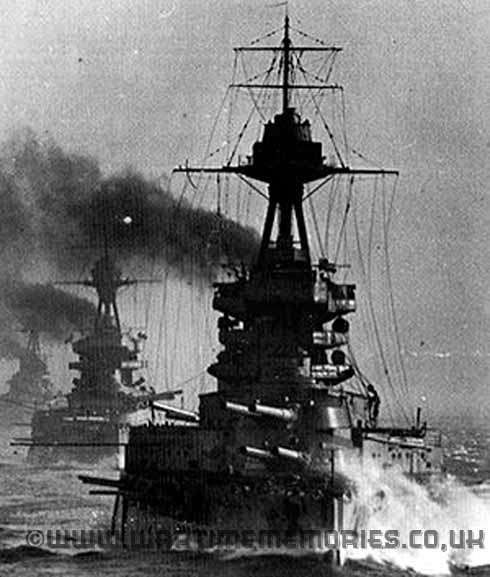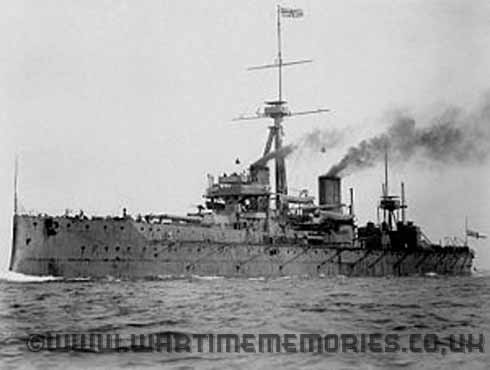
HMS Benbow
HMS Benbow was an Iron Duke-class battleship of the Royal Navy, the third ship of the class and the third ship to be named in honour of Admiral John Benbow.
She was ordered under the 1911 Naval Estimates and built in the yards of William Beardmore and Company, of Glasgow. She was laid down on 30 May 1912 and launched on 12 November 1913. She was commissioned in October 1914 after the outbreak of the First World War.
Her sister ships were: Iron Duke, Marlborough and Emperor of India.
She had a displacement of 25,000 tons / 29,500 full load
Length: 622 ft 9 in (189.8 m), Beam: 90 ft (27.4 m), Draught: 32 ft 9 in (9.98 m)
Her propulsion was 4 shaft Parsons steam turbines with direct drive, fed by 18 Babcock & Wilcox or Yarrow boilers delivering 29,000 hp,
giving her a top speed of 21.25 knots (39.4 km/h)
and a range of 14,000 nm at 10 knots (18.5 km/h)
Her armament consisted of 10 × BL 13.5-inch (342.9 mm) Mk V guns (5 × twin turrets), 12 × BL 6-inch (152.4 mm) Mk VII guns (single mounts), 2 × QF 3 inch 20 cwt AA guns
and 4 × 21-inch (533 mm) torpedo tubes
Her Armour Belt was 12 in, Bulkheads: 8 in, Barbettes: 10 in, Turrets: 11 in and Decks: 2.5 in
Benbow served as the 4th Battle Squadron's flagship until June 1916. She was initially the flagship of Admiral Douglas Gamble, until he was replaced in February 1915 by Vice-Admiral Sir Doveton Sturdee. Her commander was Captain H. W. Parker.
Prior to the Battle of Jutland, Benbow left Scapa Flow with the rest of the Grand Fleet under the command of Admiral John Jellicoe on 30 May 1916. She led the 4th Division, consisting of HMS Bellerophon, HMS Temeraire and HMS Vanguard.
She spent the remainder of the war at anchor at the 4th Division's home port of Scapa Flow, or on manoeuvres and routine patrols in the North Sea.
In 1919 Benbow was deployed in the Mediterranean, and then with the Black Sea squadron in support of the White Russians in the Russian Civil War. She carried out a number of shore bombardments, until she left the squadron in 1920. She became part of the Mediterranean fleet until 1926. Benbow's captain between 1921 and 1923 was James Fownes Somerville, later Sir James Fownes Somerville, Admiral of the Fleet.
HMS Benbow left the Mediterranean in 1926 and joined the Atlantic Fleet until 1929, when she was paid off into reserve. She was disarmed in 1930 under the terms of the London Naval Treaty and placed on the disposal list. Benbow was sold for scrap in January 1931 and scrapped in March 1931 by Metal Industries, of Rosyth.
John Doran
1st September 1914 British Battleships 
HMS Dreadnought
Name: HMS Dreadnought, Dreadnought Class Battleship.
Ordered: 1905, Builder: HM Dockyard, Portsmouth
Laid down:2 October 1905, Launched:10 February 1906.
Commissioned: 2 December 1906, Decommissioned: February 1919.
Fate: Scrapped, 1923.
Displacement: 18,120 long tons (18,410 t)
Length: 527 ft (160.6 m), Beam: 82 ft 1 in (25.0 m), Draught: 29 ft 7.5 in (9.0 m)
Installed power: 23,000 shp (17,000 kW), 18 Babcock & Wilcox water-tube boilers. Propulsion: 4 shafts, Parsons direct-drive steam turbines.
Speed: 21 knots (39 km/h; 24 mph)
Range: 6,620 nautical miles (12,260 km; 7,620 mi) at 10 knots (19 km/h; 12 mph)
Crew complement: 700,810 officers and ratings.
Arament and Armour.
- Armament:
- 5 × twin BL 12-inch Mark X guns
- 27 × single 12-pdr 18 cwt Mark I guns
- 5 × 18-inch (450 mm) torpedo tubes
- Armour:
- Belt: 4,11 in (102,279 mm)
- Deck: 0.75,3 in (19,76 mm)
- Barbettes: 4,11 in (102,279 mm)
- Turrets: 3,12 in (76,305 mm)
- Conning tower: 11 in (279 mm)
- Bulkheads: 8 in (203 mm)
HMS Dreadnought was a battleship of the Royal Navy that revolutionised naval power. Her entry into service in 1906 represented such a marked advance in naval technology that her name came to be associated with an entire generation of battleships, the "dreadnoughts", as well as the class of ships named after her. The generation of ships she made obsolete became known as "pre-dreadnoughts". She was the sixth ship of that name in the Royal Navy.
Admiral Sir John "Jacky" Fisher, First Sea Lord of the Board of Admiralty, is credited as the father of the Dreadnought. Shortly after he assumed office he ordered design studies for a battleship armed solely with 12-inch (305 mm) guns and a speed of 21 knots (39 km/h; 24 mph). He convened a "Committee on Designs" to evaluate the alternative designs and to assist in the detailed design work. One ancillary benefit of the Committee was that it would shield him and the Admiralty from political charges that they had not consulted leading experts before designing such a radically different battleship.
Dreadnought was the first battleship of her era to have a uniform main battery, rather than having a few large guns complemented by a heavy secondary battery of smaller guns. She was also the first capital ship to be powered by steam turbines, making her the fastest battleship in the world at the time of her completion. Her launch helped spark a naval arms race as navies around the world, particularly the German Imperial Navy rushed to match her in the build-up to World War I.
Dreadnought did not participate in any of World War I's naval battles as she was being refitted during the Battle of Jutland in 1916. This was the only time that British dreadnought battleships fired on their German counterparts during the war. She became the only battleship to sink a submarine when she rammed the SM U-29 when it unexpectedly broke the surface after firing a torpedo at another dreadnought in 1915. She was relegated to coastal defence duties in the English Channel after Jutland, only rejoining the Grand Fleet in 1918. She was reduced to reserve in 1919 and sold for scrap two years later.
Dreadnought became flagship of the 4th Battle Squadron in December 1912 after her transfer from the 1st Battle Squadron, as the 1st Division had been renamed earlier in the year. Between September and December 1913 she was training in the Mediterranean Sea. At the outbreak of World War I in 1914, she was flagship of the 4th Battle Squadron in the North Sea, based at Scapa Flow. She was relieved as flagship on 10 December by HMS Benbow.
Ironically for a vessel designed to engage enemy battleships, her only significant action was the ramming and sinking of German submarine SM U-29, skippered by K/Lt Otto Weddigen (of SM U-9 fame), on 18 March 1915. U-29 had broken the surface immediately ahead of Dreadnought after firing a torpedo at HMS Neptune and Dreadnought cut the submarine in two after a short chase. She almost collided with HMS Temeraire who was also attempting to ram. Dreadnought thus became the only battleship ever to sink a submarine.
John Doran
31st May 1916 HMS Benbow in Action
If you can provide any additional information, please add it here.






